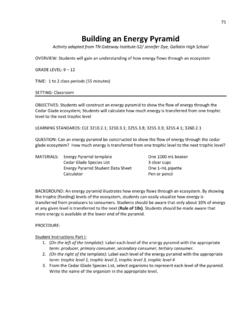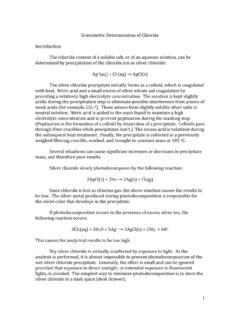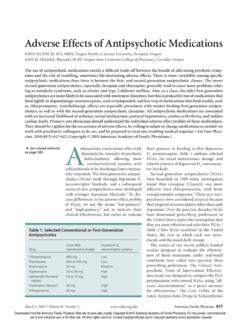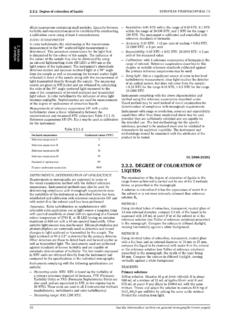Transcription of Determination!of!calcium!by!Standardized!EDTASolution ...
1 1 Determination of calcium by Standardized EDTA Solution Introduction The classic method of determining calcium and other suitable cations is titration with a standardized solution of ethylenediaminetetraacetic acid (EDTA). EDTA has the structure shown below. Instead of repeatedly drawing this structure or writing out the chemical formula, the EDTA molecule is represented as H4Y . Each acid hydrogen on EDTA can be removed, producing H3Y- 1, H2Y- 2, HY- 3, and Y- 4 ions.
2 The disodium dihydrate of EDTA, Na2H2Y 2H2O is commonly used to prepare standard EDTA solutions. CH2CH2 NNCH2 COHOCOHCH2 OCHOCH2 OCHOCH2O This salt is readily available from many commercial sources, and often in such a high purity that solutions need not be standardized for routine work. Primary standard calcium carbonate can be used to standardize EDTA solutions. Of the various EDTA species, only the Y4- ion (the completely deprotonated anion of EDTA) forms a 1:1 complex with metal ions.
3 To increase the fraction of Y4- , the pH needs to be increased to 10 in this experiment. The endpoint of an EDTA titration is determined with a metallochromic indicator. These indicators are complexing agents that change color when combined with metal ions. A variety of indicators can be used for EDTA titrations. In this experiment, we will use Eriochrome black T (EBT) indicator, having the structure shown below. NN-O3 SNO2 OHOH(H2In-) This indicator (shown as H2In- in the equations below) changes from blue to red when combined with a metal ion, forming a complex ion.
4 2 M2+ + H2In- + 2H2O <- - > MIn- + 2H3O+ blue red EDTA is a stronger complexing agent than the indicator, and displaces the indicator from the metal ion allowing the indicator to return (through shades of violet) to a pure blue color, indicating the end of the reaction.
5 MIn- + Y4- <- - > MY2- + H2In- red blue Calcium ion (Ca+2) does not form a stable red complex with the EBT indicator; therefore the direct titration of Ca2+ by EDTA may not cause a sharp color change of EBT indicator at the end point.
6 The magnesium complex with EBT is stable and the Kf of Mg2+ with EDTA is lower than the Kf of Ca2+ with EDTA. Thus, a displacement titration of Ca2+ by the mixture of Mg2+ and EDTA will help to determine the end point with the following mechanism: CaIn- + MgY2- <- - > CaY2- + MgIn- To accomplish this displacement titration, a small amount of Mg2+ will be mixed with the EDTA solution. The EDTA- Mg mixture will titrate the unknown Ca2+ solution.
7 At the end point, Mg2+ will be released from the EBT indicator and complexed with EDTA, causing the color change from red to blue. Solutions needed for this experiment: Solutions prepared by the student Solutions provided by the instructor disodium EDTA with MgCl2 (standardized by student) 12M Hydrochloric acid Standard Ca2+ solution NH3- NH4Cl Buffer Solution of egg shells Eriochrome black T indicator 3 Experimental Procedure Preparation and standardization of M EDTA solution.
8 1. Using the top loading balance, weigh between and grams of disodium EDTA dihydrate into a clean 1 L plastic bottle. EDTA will leach metal ions from soft glass containers, and should never be stored in glass containers. Add 1 L of deionized water. EDTA dissolves SLOWLY. Shaking or stirring the solution vigorously speeds the dissolution process. Nevertheless, even under these conditions EDTA dissolves SLOWLY. It is strongly recommended that the EDTA solution be prepared several hours or even the day before you plan on using it.
9 Before use, check the solution to make sure all of the solid has dissolved. 2. Using the analytical balance, weigh out ~ grams of MgCl2 and add the MgCl2 to the EDTA solution. You don t need to wait for the EDTA to dissolve before adding the magnesium chloride. 3. Dry about 1 gram of calcium carbonate (CaCO3) in the oven for 2 hours. Transfer to the desiccator and cool (~ 1 hour). When cooled, weigh a gram portion of calcium carbonate on the analytical balance and transfer it to a clean 250 mL beaker.
10 4. Add approximately 25 mL of distilled H2O, then 5 mL of conc. HCl carefully to the 250 mL beaker. Calcium carbonate reacts vigorously with acid, producing carbon dioxide gas, which may spatter the beaker contents. Cover the beaker with a watch glass. Note: If CaCO3 does not dissolve completely, add another 5 mL of conc. HCl. When the calcium carbonate has completely dissolved, boil the solution gently for 2- 5 minutes, keeping the watch glass on the beaker, to expel carbon dioxide.

















